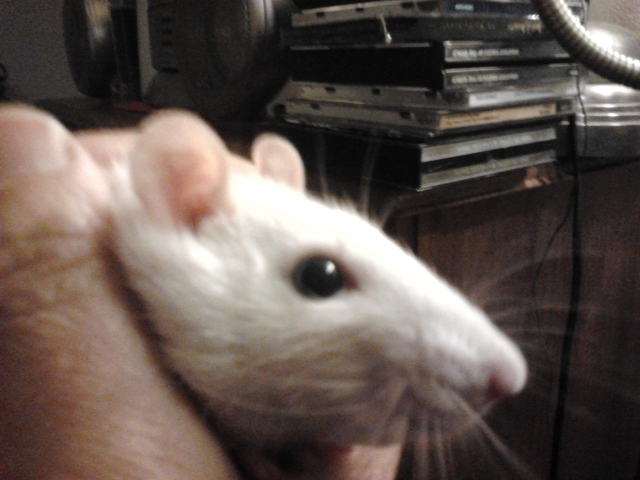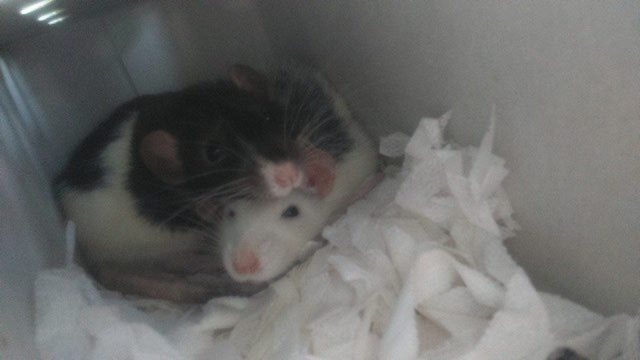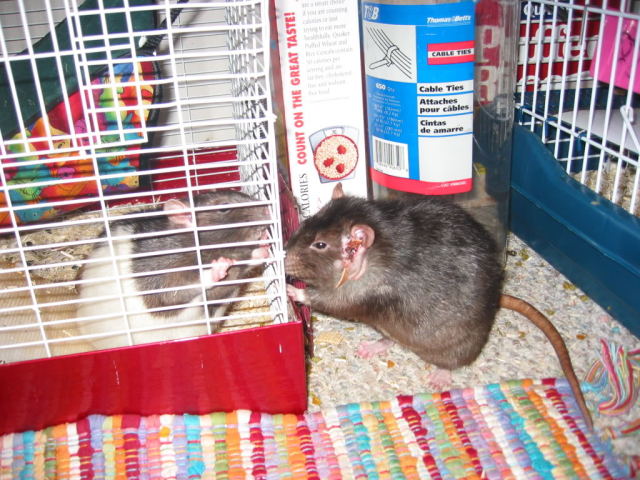QuestionAnswer -
Hi Jane-- Is your family Navy? I was stationed out in that area years ago!
Absolutely keep the little bugger. He's already bonding to you, and certainly you've done everything a good ratty mom should. There are four wild boys in our house, and you'd never guess which ones.
As he isn't raised around the parasites that he would carry from the wild, Kiwi's very unlikely to have them in the future. What you can watch for is any signs of loss of appetite, or if he isn't able to pass urine or ratty-poops. Since you're stimulating, that's less likely. Make sure his ears aren't runny, and you may note he may squeak a bit when he's hungry or if he needs you to cuddle him a bit. After three or four weeks, you can take him to a vet, to have his heart and lungs checked. My hope is that his mom didn't abandon him because of heart issues.
Baby rats start behaving like 'little popcorns' as one of my group members says, just after their eyes open and they use time to explore. It's important to keep holding him as much as you can during the first two weeks his eyes are open. When he can't see, he is bonded to the smells around him. When he opens his eyes, he SEES who mom is, so it's important that the kids hold him as often as possible. (Carefully! They have squishy little fragile bones!)
Soy milk or kitten milk should be fine, but you can start weaning him off of this in about five weeks. Slowly add water more and more. Have a water bottle available to him after about 15 days so he starts using that. Orphaned rats may take a little longer to wean, but they can still have soft food during this time. Start adding human-baby foods after three weeks. One of the greatest rites of passages for a baby ratty is the day he has his first Cheerio! (The non-sweetened kind of oat ring cereals are fine for treats, and they go NUTTY for them!)
About the time her eyes are opened you'll probably start seeing poops magically appearing on their own without your help. If you don't see any for a few hours, then you can gently rub her backside to see if she's got anything waiting to come out.
Since it's summer time, once she's fully fuzzy she won't need extra heating pads. The cloths you've provided will be just fine. Keep her out of direct sunlight, and away from any direct A/C and she should be okay. You can give her little boxes to hide in. They seem to love tissue boxes.
If she's going to be a lone rattlette, you want to make sure she gets a lot of people time. They need to have tribes, so they need to have knowledge that the tribe hasn't left them. You'll start to see more of her personality at about three weeks old. One of my boys used to climb into my shirt around that age, and did so until the day he died three years later. Another girly of ours was a groomer..she'd give everyone ratty kisses, and play with the hair of whomever she'd be sitting on. When we ever brought in new kits, she'd be the first to welcome and groom them.
The one thing I'd be a bit cautious about: Wild rats have different life spans than pet rats from lab backgrounds. Often it's a longer life, but abandoned kits tend to have heart issues. Whenever you get her to a vet, be sure that her heart is checked. The good news is they have less of a chance for tumors or other issues bred in by labs.
CongRATulations on Kiwi. It sounds like she found the best family! I hope she continues to grow strong for you!
Cathe
Thanks for the info, I feel much better now. I am one of those rare people who were born and raised in Va Beach (they do exist!) you should come and see what is new and how things have changed. It is much nicer now!
Kiwi's eyes are starting to open! She knows when I go into the room so I know she knows who I am. How do I distinguish between a Norway Rat and a Roof Rat? I have read that a Roof Rat does not make a good pet. Is this true? Kiwi is gray with a few light hairs in her body. Her tail is also dark gray and about the same length as her body (2 inches) - yes, I tried to measure it. Her ears are still not sitting up so I do not know if they are "large" or not. Her snout at this stage is "pointed" but I am not sure if this is because of her age or type. Either way, we love her and are thankful that we could rescue her. I found out today that the person who had the nest in his yard called the exterminator and had all Kiwi's brothers and sisters plus mom killed. I understand why he did it but he could have moved them to a new location. Everything has a purpose. Enough of that. Roof Rat or not? How do I know?
Thanks again,
Jane Cecelic and family
AnswerHello Again!
I'm looking forward to seeing how Mt. Trashmore has changed especially! We used to surf with the dolphins at the beach, too.
I'm glad your kids are learning so much from their new baby. It sounds like a standard Norwegian. But the roof rat story is only true if you get a wild rat which hasn't had much human contact. We used to feed some wild brown rats outside of our house in New Mexico. As they were familiar with our schedule and feeding times, the kits were always very friendly. The mom was a bit more cautious but the dad would just wait outside our back porch for us to bring him some grapes.
I've heard tales of people taking in older sick rats and nursing them. But as the rats were used to the ways of the wild, they had a harder time taking to the taming. It's absolutely a matter of patience. CocoPuff, our oldest wild Norwegian, is three, and JUST starting to cuddle with us. He arrived as a rescue when he was well over six months old. He was hand shy, but knew who was feeding him. We've taken enormous patience and kindness with him, and he now lets us hold him for several minutes before he remembers he's a wild boy!
There are some terrific rat books available at local pet stores, but they seem to be a bit pricey. I recommend getting used books from Mom & Pop shops, online or offline. One of the better books is "Training Your Pet Rat" (ISBN: 0-8120-4535-1) by Gerry Bucsis and Barbara Somerville. Another great handbook to have is the Rat Care Book by Debbie Duccommon and it is available at her RatFanClub.org site. There are some things in it I would run by a vet first, but generally it's pretty dead-on for health care. She may even have a downloadable copy available.
A great way to learn to care for the little Kiwi is to join a local rat group, or an online one. Our group is Ratzen Mauzers, an RMCA group out of Las Vegas, NV. But I know of several chapters in DC, Richmond, and even Chapel Hill. If you visit RMCA.org you can see the listings. I find having other local rat lovers makes it easier to trade and share tips and tricks. Kids are great at the meetings as they are able to talk about their own little kits!
Thanks so much for taking little Kiwi in-- it sounds like she has a terrific start to a special life!
Cathe

 Strange growth on rat
QuestionQUESTION: My rat, Scott, has developed a strang
Strange growth on rat
QuestionQUESTION: My rat, Scott, has developed a strang
 Is this cage big enough for two male rats?
QuestionQUESTION: I saw this cage on petsmart.com and w
Is this cage big enough for two male rats?
QuestionQUESTION: I saw this cage on petsmart.com and w
 rat eye issue
Question
normal eye bad eye
Hi again nata
rat eye issue
Question
normal eye bad eye
Hi again nata
 Smelly Male Rats
Question
Photos of them both
Hi, I was wondering
Smelly Male Rats
Question
Photos of them both
Hi, I was wondering
 RE: Male rat has an abscess that wont go away
QuestionQUESTION: Hi there. Im not sure what to d
RE: Male rat has an abscess that wont go away
QuestionQUESTION: Hi there. Im not sure what to d